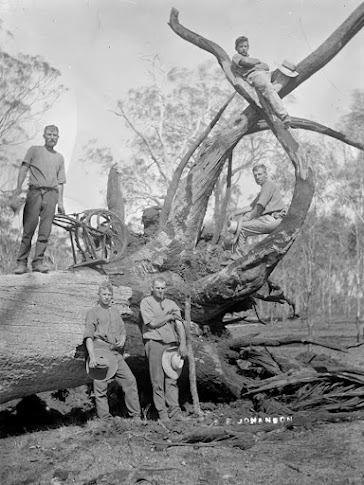Edward Malone, Joseph Wilson and The White Swan
Edward Malone (pictured) and Joseph Thomas Wilson were rival publicans and bush poets in Swan Creek in the 19th century.
These two colourful characters began as pioneer farmers in the Swan Creek district. In May 1868, Wilson was granted 18 acres (portion 284) of the farming land excised from Canning Downs as the Warwick Agricultural Reserve; in 1876, Malone owned 75 acres of land on which he built a two-storey sandstone house.

But both Wilson and Malone decided to become publicans.
When the second Country Publican's General License in the growing town of Swan Creek was issued to Wilson, he opened the Cottage Inn, later (1875) opening the eponymous Wilson's Hotel. In May 1878, Malone successfully applied for a license to operate The White Swan from his sandstone home.

The story goes that he was inebriated after celebrating the birth of his youngest child and mistook the swaddled infant in a basket near the fire for firewood! The baby was rescued from the fire by the midwife but the penitent father immediately swore off the grog, named the child Temperance*, and set up a new, temperance hotel in Jack Smith’s Gully (Swan Creek).
While very appealing, the story may well be apocryphal because Temperance was born on 23 December 1882, long after her father had set up his hotel.
However, the rivalry between Wilson and Malone was real.
In March 1882, Wilson placed a 'pro-water' sign on a post near The White Swan, Malone (an Irishman known locally as a wit) responded in verse, publishing the following in the advertising pages of The Warwick Argus on 11 March 1882.
The dispute became personal when Wilson responded with his own advertisement, 10 days later, calling Malone a 'lazy, short, fat, maligning publican'.
To the amusement of the populace (and no doubt the economic benefit of both publicans) the exchange continued, Malone later publishing the 'advertisements' in a book entitled 'Rhymes', together with other verse he had written. The review below appeared in The Worker in August 1912.
The derelict White Swan, 1972
Extensive restoration and renovation was conducted, including demolition of the detached wooden kitchen in 1976 and construction of a modern annexe utilising some demolition materials from Warwick's Bank of New South Wales, including bricks for the fireplace.
Bank of New South Wales, cnr Palmerin and Fitzroy Sts, c. 1905 (SLQ Collection)
The Tysons had also intended to use some of the sandstone and while this proved unviable, some of the larger sandstone blocks were subsequently used in the 2001 restoration of Glengallan, and carved sandstone architectural features from the Bank building now feature in the Locke Street (Warwick) garden of one-time White Swan owners, Donna and Ross Fraser.
On 1 November 1983, the restored White Swan was registered on the Australian Heritage Database maintained by the Australian Government's Department of Agriculture, Water and the Environment as "a representative of the sandstone building tradition of the Warwick district" and as "a relic of a now outdated mode of transport, namely coaching". As at December 2021, the Commission notes that it is "in the process of developing and/or upgrading official statements for places listed prior to 1991" and that "the above data was mainly provided by the nominator and has not yet been revised by the Commission".
The building was added to the Queensland Heritage Register on 21 October 1992 and is included in the local Southern Downs register.
The restored White Swan today is a private residence
(Department of Environment and Heritage photograph, 2017)
The Swan Creek district, situated 13 km from Warwick, was one of the first areas in the south-eastern Downs to be occupied by a farming community. In 1827, Allan Cunningham traversed the valley which later became known as Jack Smith's Gully, after an early pioneer in that locality. It is thought that the district was named Swan Creek because swans were among the many species of birds found there in the early days of settlement.
Swan Creek 1899
(This blog includes information and photographs from the history of the Malone family and The White Swan in Donna Fraser's posts on Lost Faces of Warwick Facebook page. It also contains information from the Queensland Heritage Register: https://apps.des.qld.gov.au/heritage-register/detail/?id=600523#)























































